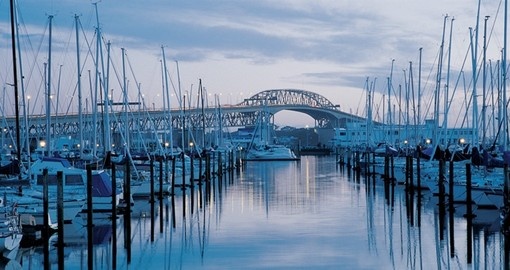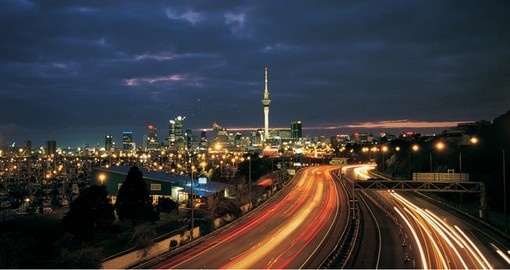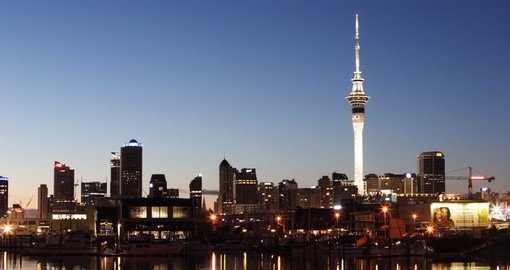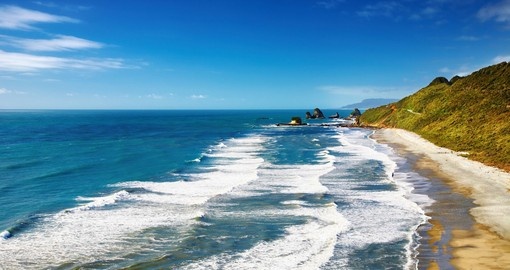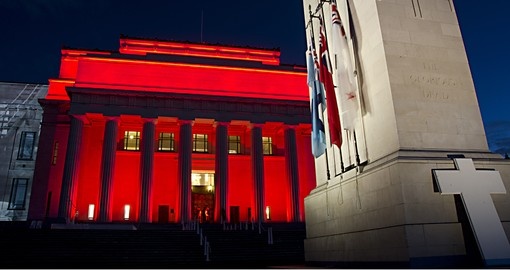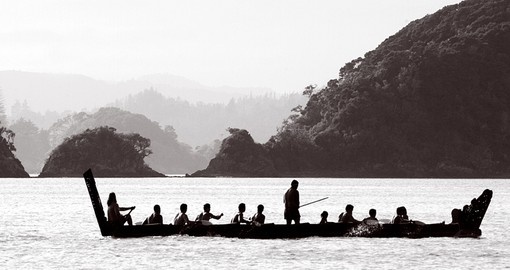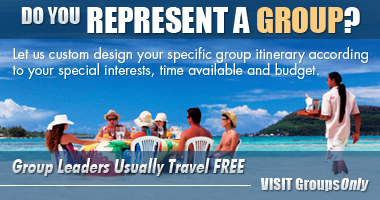New Zealand North Island Top Spots
This page details some of the top regions to explore on New Zealand's North Island, along with some independent travel ideas that can be included in your itinerary.
Visit the South Island's Top Spots page.
NORTHLAND
The region known as Northland lies to the north of Auckland. Northland is almost sub-tropical with small country towns, island-studded bays, long sandy beaches, and pockets of subtropical forest. It is also of significant historical importance. In 1840, Maori and European inhabitants signed the Treaty of Waitangi joining the two as one nation.
WHANGAREI
Whangarei is the largest centre in Northland with a population of over 44,000 and a wide range of accommodations, restaurants, craft shops, and attractive gardens including a fernery and conservatory. Many sheltered surf beaches are within an easy 45-minute drive from Whangarei.
THE BAY OF ISLANDS
More than 150 islands that dot the series of inlets and bays surrounding the small towns of Paihia, Russell, and Waitangi make up the Bay of Islands.
Paihia is the main visitor centre offering a wide range of accommodations and excellent seafood restaurants and is also the departure point for most excursions.
Waitangi, within walking distance of Paihia, is the site where the Treaty of Waitangi was signed in 1840 between Maori Chiefs and representatives of the British Crown.
Russell is one of the oldest towns in New Zealand and is a 20-minute ferry ride from Paihia. Cars may be transported by the vehicular ferry from nearby Opua, a deep-water port.
Kerikeri, 14 miles/23 km to the north of the Bay of Islands is a thriving small town. Surrounded by citrus orchards, Kerikeri has many crafts and shops on its main street.
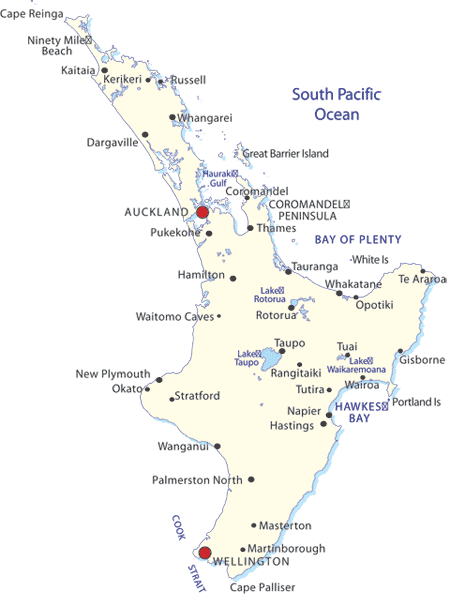
AUCKLAND
The main gateway to New Zealand, Auckland has a multicultural population of more than a million people and is New Zealand's largest city surrounded by expansive parklands and water. Cultured and cosmopolitan, progressive and historic, Polynesian and European, accessible to beaches and forests, adventure sports, and leisure activities, Auckland offers something for everyone. Auckland sprawls for 30 miles/48 km over the narrow isthmus that separates its two harbours - the Waitemata to the east and the Manukau to the west. Auckland offers both sheltered and rugged surf beaches, a harbor scattered with islands, large farm-like parks, reserves, and bush-clad ranges, and a skyline clearly showing the remains of many of the 48 extinct volcanoes on which Auckland was built. Expect great shopping, dining and entertainment, and the bustle of an international city. There are more boats per capita in Auckland than in any other city in the world.
COROMANDEL PENINSULA
The Coromandel Peninsula is covered in native forest and bush and is surrounded by a stunning beach-studded east coast. The region is a popular holiday resort for Aucklanders and is also home to many craftspeople and seekers of alternative lifestyles. A strong conservationist lobby among the sparse population has preserved the Coromandel's unspoiled state. At one time gold, Kauri logs, and gum were all extracted from the rugged forest country. The Coromandel Peninsula offers many excellent sandy beaches for surfing, fishing, and swimming. Big-game fishing and hiking are also popular activities. Towns that make up the Coromandel Peninsula include Thames, the largest town, Coromandel, one hour's drive north of Thames, and Whitianga, the second largest town on the Coromandel Peninsula. Other areas to visit include Whangamata, Pauanui, Mercury Bay, Hahei, Paeroa, and Waihi.
BAY OF PLENTY
Tauranga, Maori for sheltered waters, is the largest residential and commercial area of the coastal Bay of Plenty. This region enjoys one of the sunniest climates in New Zealand, ideal for growing kiwi and citrus fruit for which the region is famous. A harbour bridge links Tauranga with Mount Maunganui, one of New Zealand's largest ports, and among its most popular beach resorts. The whole Bay of Plenty region offers outstanding surf beaches as well as magnificent waters for big game fishing. Located on the eastern edge of the Central North Island's thermal region, the Bay of Plenty has thermal hot pools as well as one of the world's most accessible active volcanoes, White Island, 30 miles/48 km offshore from Whakatane.
WAIKATO AND WAITOMO
Hamilton is the main center of the Waikato and is located on the Waikato River, the longest in New Zealand at 265 miles. Hamilton is supported by small prosperous towns such as Cambridge, known for its large English trees; Te Awamutu, renowned for its rose gardens and historic St. Johns Anglican Church; Otorohanga, whose zoo boasts the largest walk-through aviary in the Southern Hemisphere; and Matamata, the centre of the country's bloodstock industry. The Waikato region is one of the world's greenest. The volcano-enriched soil supports lush grass for raising cattle and thoroughbred horses.
The major attraction in the area is the famous Waitomo Caves with its glow worm grotto and limestone caverns. Less than 50 miles to the south of Hamilton, the Waitomo Caves make up a vast underground network of water-sculpted, limestone grottoes. Here you can go tube rafting on an underground stream or slip silently through on a barge to view the magical lighting created by glowworms overhead. The more adventurous may abseil (rappel) 300 feet down into huge caverns. No previous experience is required to do this.
ROTORUA
The lakeside city of Rotorua is one of North Island's most famous destinations for overseas visitors and an important center of Maori culture.
Rotorua is also the centre of New Zealand's thermal region, with geysers, steaming lakes and streams, mud pools, multi-coloured silica terraces, and hot mineral pools known for their curative properties. Rotorua has some of the best trout fishing in New Zealand and 11 major lakes to choose from.
For centuries the Maori have taken advantage of the hot springs for cooking and bathing, and Rotorua is one of the best places to learn about their culture, both traditional and contemporary. At the Maori Arts and Crafts Institute in the Whakarewarewa Reserve, you can watch highly skilled Maori carvers and weavers at work. A hangi or feast is the traditional method used by the Maori to prepare their food. Food is cooked underground and heated by the thermally heated earth. Many hotels offer Maori concerts and the chance to sample this very distinctive type of food. Many maraes or meeting houses also offer a hangi feast and concert.
TAUPO
An hour's drive south from Rotorua, Taupo sits on the northern shore of Lake Taupo, New Zealand's largest lake."The trout capital of New Zealand," Lake Taupo is justly renowned for its fishing, and plenty of guides and boats are available. Many people just enjoy cruising or simply relaxing in this incredibly beautiful spot. For the more active, there are helicopter rides, horse treks, bungee jumping, rafting, and golfing. At the southern end of the lake is Turangi, also famous for its trout fishing. This is the base for white-water rafting on the Tongariro River.
TONGARIRO NATIONAL PARK
In the park, Mount Ruapehu (9,177 feet), the highest peak on the North Island and a live volcano, is the site of the Whakapapa and Turoa ski areas which both have world-class facilities. For summer, there are extensive tracks and huts throughout the park, as well as shorter walks and nature trails, and historical Maori sites. The town of National Park services the ski area of Whakapapa. Ohakune is the town at the base of the Turoa Skifield.
THE EAST COAST
The eastern region of the North Island, Eastland, is noted for its sparse population, proud Maori history, and high rugged mountains. From the tallest of these, Mount Hikurangi, you can be the first in the world to see the dawning of the new day. Along the coast, from Opotiki to Gisborne, a stunning 200-mile drive winds slowly and scenically around the entire East Cape. This is an ideal motorhome or camping country, where there are no large towns, only small villages selling provisions and fuel. Behind these small, historic coastal settlements is wild, mountainous sheep ranching country.
GISBORNE
The main city of the isolated Eastland region, Gisborne is a pleasant resort town situated on a broad bay. The surf beaches and sunny, warm climate here have long attracted New Zealanders on vacation. The area boasts some of the country's best surviving carved Maori meeting houses and churches. West of Gisborne, the vast, remote, forested wilderness of the Te Urewera National Park is the largest untouched expanse of native forest in the North Island, beautifully endowed with lakes, rivers, and waterfalls. The scenic highlight is the sparkling gem of Lake Waikaremoana, and there are excellent hiking trails and short walks here, including the 30-mile Lake Waikaremoana Track. Bird watching, hunting, fishing, canoeing, and boating are all spectacular.
NAPIER - HAWKE'S BAY
Napier is the port for the Hawke's Bay region. It is best known for its man-made treasure - its glorious Art Deco buildings. Built following a disastrous earthquake and fire which destroyed the city in 1931, Napier now claims to have the largest concentration of Art Deco buildings in the world. well preserved or beautifully restored. Interesting and informative guided Art Deco walks are provided by the local Art Deco Trust.
Sightseeing must is the beautifully landscaped, oceanfront Marine Parade, with its gardens and many attractions. The city's cafes and restaurants add to the ambiance of a charming seaside resort.
Hawke's Bay is famous for its world-class wines and is home to 30 wineries. The region is also New Zealand's largest producer of apples, pears, and peaches.
The twin city of Hastings is about 16 miles from Napier and is the seat of the region's orchards and vineyards, many of which have fine cafes serving Mediterranean-style food with their premium wines.
Visit the gannet sanctuary at Cape Kidnappers, the largest mainland colony in the world. For magnificent views of the bay and surrounding countryside, drive up Te Mata Peak, past the town of Havelock North.
TARANAKI
The most striking natural feature of Taranaki is the classic, almost symmetrical volcanic cone of Mt.Taranaki (also known as Mt. Egmont). A drive, or walk on one of the many forested mountain trails on Mt. Taranaki affords spectacular views of the almost perfectly circular park spread out below. Greener-than-green dairy pastures stretch as far as the eye can see. Not to be missed are the beautiful Dawson Falls.
The main provincial centre is New Plymouth and other smaller towns are Inglewood, Stratford, Eltham, and Hawera. Surfing is also popular on this rugged coastline.
WANGANUI
In an area of coastal farmlands and small rural communities, the city of Wanganui lies at the mouth of the historic Whanganui River. Visitors can travel upriver by jet boat or riverboat into the heart of the Whanganui National Park, or canoe downstream over gentle rapids. You can visit villages along the way, where local Maori welcome visitors.
RANGITIKEI
The Rangitikei region includes the towns of Taihape, Mangaweka, Hunterville, Marton, and Fielding. There is a huge range of wonderful bed and breakfasts and farm stays that feature glorious gardens such as Rathmoy, Cross Hills, Cairnmuir, Titoki Point, and Lavender Farm.
Rafting on the Rangitikei River, horse trekking, jet sprinting, and a wide selection of crafts from pottery, to ceramics are also on offer. Just over 2 hours from Wellington and less than an hour to the closest skifield the Rangitikei is perfectly located on State highway 1.
PALMERSTON NORTH
Palmerston North serves the surrounding wealthy sheep and cattle farming region, commonly referred to as Manawatu. Many large and beautiful private gardens are available for viewing. Garden tours are extremely popular here.
THE CENTRAL REGION
This region of New Zealand encompasses parts of both the North and South Islands. In the North Island, Wellington, the nation's capital, and the Wairarapa make up part of this region while in the South Island, Marlborough and Nelson complete the union. All four areas complement each other and offer an excellent way to experience a great deal of New Zealand in a short amount of time.
WELLINGTON
New Zealand's capital is a superbly compact city, set dramatically on the shores of a fine, deep harbour enclosed by a natural amphitheater of wooded hills. The second-largest city, Wellington is the political center of New Zealand. Wellington has a vast range of accommodations ranging from top-class hotels to middle-of-the-range, budget, and apartment-style accommodations. Vibrant, exciting, and cultured, it combines the stimulation of a sophisticated big city with the friendliness and warmth New Zealanders are famous for.
Wellington is known as the restaurant capital of New Zealand. Many of its great cafes, funky bars, and ethnic-inspired restaurants are within walking distance of each other, and its sidewalks are enlivened by street performers. Look for restaurants and bars in the Courtney Place area, namely Blair and Allen Streets, or try the Queen's Wharf. Wellington's nightlife is a tribute to its passion for the arts. It is home to the national orchestra, ballet and opera companies, four professional theatres, and the national schools of dance and drama.
The Kapiti Coast is 20 miles/32 km north of Wellington city. A popular spot for Wellingtonians to spend their holidays, the Kapiti Coast has white-water rafting, swimming, boating, hunting, golf, horseback riding, and bushwalking.
WAIRARAPA
The Wairarapa is fast gaining a reputation for its award-winning wines. Most of the wineries are within walking distance of each other, clustered around the colonial village of Martinborough, which also has excellent restaurants and craft shops. About one and a half hours' drive north of Wellington, Masterton is the main centre of a rich, sheep-farming district.
New Zealand Travel Information
At Goway we believe that a well-informed traveller is a safer traveller. With this in mind, we have compiled an easy-to-navigate travel information section dedicated to New Zealand.
Learn about the history and culture of New Zealand, the must-try food and drink, and what to pack in your suitcase. Read about New Zealand's nature and wildlife, weather, and geography, along with 'Country Quickfacts' compiled by our travel experts. Our globetrotting tips, as well as our visa and health information, will help ensure you're properly prepared for a safe and enjoyable trip. The only way you could possibly learn more is by embarking on your journey and discovering New Zealand for yourself. Start exploring...book one of our New Zealand tours today!
Extend Your Stay
Consider an additional stopover to your New Zealand vacation at one of Goway's South Pacific destinations. You can choose from our selection of Australian vacations, Tahiti vacation packages or stay at one of our Fiji resorts or perhaps take a Cook Island vacation. This can be done by stopping over en route to or from New Zealand.
Book your New Zealand tour with Goway!
With more than 150 New Zealand tours and experiences, Goway’s Downunder wizards can offer you many ways to explore and enjoy New Zealand. Choose from a simple city stopover, see the country highlights on one of our classic itineraries, a self-drive holiday, a Holiday of a Lifetime, and more. We want to be your first choice when next you go globetrotting to New Zealand.
Get a Trip Quote Order a Brochure







